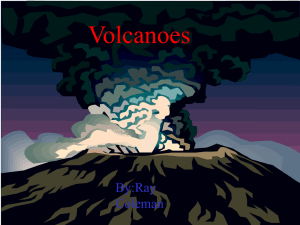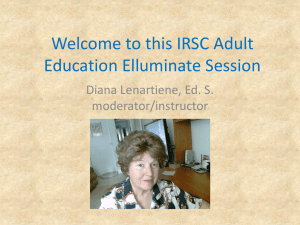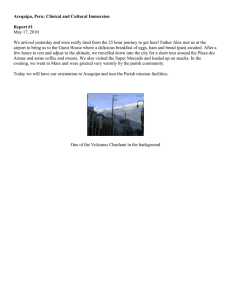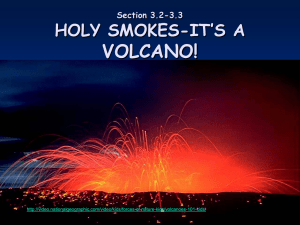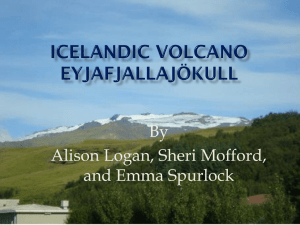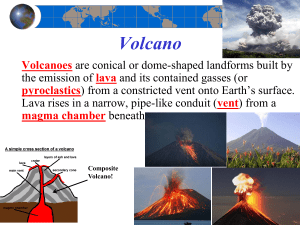Innovation of Mathematics Education through Lesson Study
advertisement
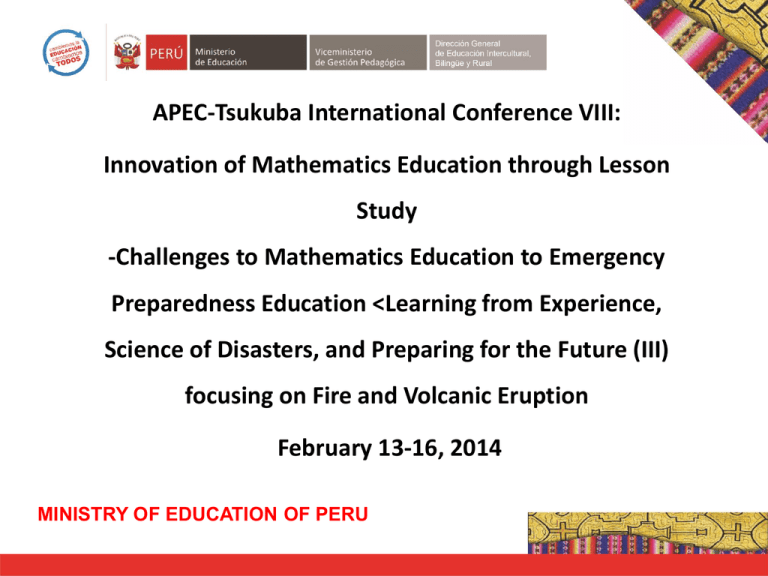
APEC-Tsukuba International Conference VIII: Innovation of Mathematics Education through Lesson Study -Challenges to Mathematics Education to Emergency Preparedness Education <Learning from Experience, Science of Disasters, and Preparing for the Future (III) focusing on Fire and Volcanic Eruption February 13-16, 2014 MINISTRY OF EDUCATION OF PERU The major active volcanoes in Peru The south of Peru is part of the Andes Volcanic Zone that extending up to northern Chile. There are over 400 volcanoes in Peru. Most of these volcanoes are no longer active and do not represent any danger so it is Misti, Ubinas, Huaynaputina, Ticsani, Sara Sara, Sabancaya, Coropuna, Ampato, Tutupaca, Yucamane, Purupuruni and Casiri,and there are more volcanoes of which little activity. Misti and Volcanic Risk in Arequipa The city of Arequipa is located on the south and south-west of the Misti volcano (5822 m) (Fig. 1). Although the city center is at a distance of only 17 km from the crater, the city is still closer to the volcano (Fig 2). Indeed, new settlements are now only 13 km from the crater. Sabancaya Volcano It belongs to the Ampato-Sabancaya-Hualca Hualca volcanic complex, the latest eruption began in November 1986, the ashes arrived to the city of Arequipa, this activity was decreasing until 1993. Currently maintains a very low activity. Volcano Ubinas It is located approximately 70 km northeast of the city of Arequipa, Moquegua Region. Ubinas valley, the main town is located only 6 km from the summit. With about 24 eruptions in the last 5 centuries. On April 20 of 2006, the volcano became active with a loud explosion that reached a column 3km higher. This explosive activity continued until late 2009. One of the strongest explosions reached 9km radius, and incandescent lava fragments were projected up to 200m. This volcanic activity, in that period of time caused major losses of cattle among other material goods. In September 2013, again was activated with 8 eruptions in 4 days and causing alarm among residents. The volcanic explosion occurred at a depth of 1000 meters. Peru and much of South America has been dealing with extreme cold front blowing across the continent of Antartica. Peru seems to have been the worst affected region, with the heaviest snowfall that the nation has seen in decades. The Geophysical Institute of Peru reported that volcanic explosions were purely groundwater, accumulation of precipitation, snowfall inside Ubinas volcano caused the pressure below the surface. Civil Defense reported that the ashes mountain ash are impacting on the health of some seven thousand habitants located in nearby towns. In Querapi,-located just four kilometers away(Arequipa), the villagers ask for their relocation, since they indicate that children begin to have discomfort in the eye and skin irritation, and animals are at risk of dying because consumption of contaminated pastures. Also reports of 9 communities that are affected by the gases emitted by the crater, this is manifested in conjunctivitis and corneal lacerations and dermatitis, gastrointestinal and respiratory illnesses. The contamination of water sources. In addition, the mobilization of a brigade is contemplated to monitor the quality of water used by residents, and the provision of drugs for the treatment of the eye and gastrointestinal and respiratory problems. . FUNDAMENTAL LEARNING NATIONAL CURRICULUM FRAMEWORK The Ministry of Education is developing a new curriculum, emphasizing the areas of communication, mathematics, science and citizenship, so it have been developed document that consider the skills and competences to implement in schools. There is also the Directorate of Community and Environmental Education, that responsability is the policies governing risk preparedness and natural disasters. Currently there are training educational communities in order to engage everyone in the organization and mobilization before a probable disaster. FORMULATE AND SOLVE PROBLEMS USING STRATEGIES AND MATHEMATICAL PROCEDURES It means that all students pose and solve various situations problems of real context, mathematical and / or scientific that involve building and use of mathematical knowledge using different strategies, arguing and evaluating its procedures and results. Numbers and Operations Understanding and use of numbers and operations, relationships, decimal system, units of time, mass, temperature, money system, and the implementation of operations in problematic situations. Change and relationships Interpretation and generalization of patterns, regularities, using equalities and inequalities, change analysis and modeling functions and interpretation of situations in order to formulate and argue. Geometry It refers to the processes of visualization and interpretation of properties and relationships of geometric shapes, properties, description of measurement methods and attributes to model real situations and resolve them. It also involves the processes of location, transformation and movement. Statistics and probability It involves processes of data collection and processing, interpretation, evaluation, and analysis of uncertainty. It implies the develop capabilities of collecting, classifying, representing data, reading and interpretation and assessment of their relevance, and the modeling of a situation and occurrence of processes, in order to relate, predict and make decisions unfold PROJECT PLAN • 24 Regions • 72 Rural Education Networks • 72 Teams of pedagogical counselors: 6 counselors for each net. • 1156 Educational institutions • 55 000 Students Construction of IIEE and CRA INFRASTRUCTURE: improvement of equipment, ODA TIC: Support for management of TIC resources furniture, infrastructure Advisory teams Currículum Initial Original language Spanish Mathematics Productive Communitary DECENTRALISED MANAGEMENT Advisory teams TRAINING Ministry of Education Currículum Initial Original language Spanish Mathematics Productive Communitary •Collaborative programming of class activities. •Observation of class sessions. •Reflection of teaching practice PRODUCT: Improvement of teaching practice Development of a guide with the best sessions activities CONTENTS OF TRAINING PROGRAM • Intercultural pedagogy. • Pedagogical support: guidelines for pedagogical advice. • Leadership. • Didactic: communication, mathematics, native languages, curricula, community education and productive education. TRAINING WORKSHOP I: January 20 - February 20, 2014 •Currently, we are training 72 teams pedagogical counselors of the 24 regions. •Training modules for teaching in each area have been prepared, including the math area. •Educational institutions in rural area, are the most exposed to the phenomena and disasters such as floods, landslides and volcanoes. •The case of risk exposure due to volcanoes, is typical of the rural schools in scattered areas, the type of Moquegua and Arequipa regions. •The context of risk and disaster preparedness has been included in the mathematical content module. PRODUCT Improvement of teaching practice Development of a guide with the best sessions activities • Good teaching practice is characterized by an adequate methodology and relevant to the needs and demands of students. • Children actively participate in class, provided that the situations and activities will be necessary for their context, and interesting • In this sense, the context of risk and disaster preparedness since education is a topic to be discussed at a general level, with participation and organization of the school and community, but also in the areas of curriculum development. ACTIVITY The red triangles indicate the most active volcanoes of Peru According to the Geographical Institute of Peru, the Misti is 17 km from the city of Arequipa and ubinas is 70km to Moquegua Which is the own region that it belong? Task 1: Highlights the city where you are, on the map. What is the closest to your city / community volcano? Calculate the approximate distance from your city to each of the volcanoes. Explain. Task 2 Put a grid over the map and marks the coordinate to find each volcano, How do you calculate the distance from your city to each of the volcanoes?. Calculates distances. How different is it to compare to result of Task 1? Why do you think this happens? Task 3 According to reports, the explosion of the volcano Ubinas in 2009 reached 9km radius. Points on the map the approximate area was invaded by lava from volcano Ubinas. Which cities were affected?



